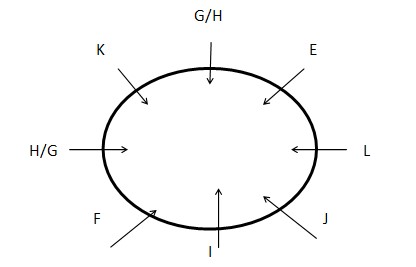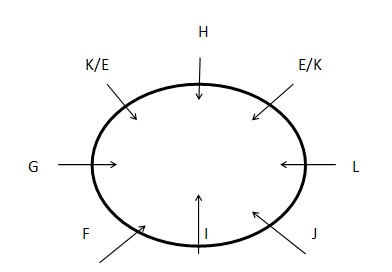Question
Eight person namely – E, F, G, H, I, J, K and L are
sitting in a circular table facing centre not necessary in same order. Who sits immediate left of J? I. I sits third to the left of E. K, who neither sits adjacent to E nor I, sits second to the left of F. Only one person sits between G and H. E and L sits together. II. Only one person sits between F and J. G, who neither sits adjacent to J nor H, sits facing L. H sits third to the left of F. I sits second to the left of L. Each of the questions below consists of a question and two statements numbered I and II given below it. You have to decide whether the data provided in the statements are sufficient to answer the question:Solution
From I: I sits third to left of E. K, who neither sits adjacent to E nor I, sits second to the left of F, that means F sits second to the right of I. Only one person sits between G and H. E and L sits together, that means L sits to the immediate left of E. Based on above given information we have:  Clearly, only two people sit between J and G. Hence, statement I is alone sufficient. From II:H sits third to left of F. Only one person sits between F and J. G, who neither sits adjacent to J nor H, sits facing L. I sits second to left of L, that means I sits immediate right of F. Based on above given information we have:
Clearly, only two people sit between J and G. Hence, statement I is alone sufficient. From II:H sits third to left of F. Only one person sits between F and J. G, who neither sits adjacent to J nor H, sits facing L. I sits second to left of L, that means I sits immediate right of F. Based on above given information we have:  Clearly, only two people sits between J and G. Hence, statement II is alone sufficient.
Clearly, only two people sits between J and G. Hence, statement II is alone sufficient.
Which among the following devices is also known as Visual Display Unit (VDU)?
What is the smallest and largest font size available in Font Size tool on formatting toolbar?
Which of the following number system has base-16?
___________ is a passage to connect two networks that may work on different networking models.
Which of the following is not true about RAM?
Files created with Lotus 1-2-3 have an extension
What happens when you press the ctrl + v key?
What does a light pen contain?
Which of the following stores data in non-volatile memory?
Which of the following options is not related to MS Office?
Relevant for Exams:


